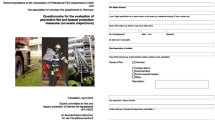Abstract
The collapse of the World Trade Center buildings on September 11, 2001 posed questions on the stability of tall buildings in fire. Understanding the collapse of the WTC Towers offers the opportunity to learn useful engineering lessons in order to improve the design of future tall buildings against fire induced collapse. This paper extends previous research on the modelling of the collapse of the WTC Towers on September 11, 2001 using a newly developed “structures in fire” simulation capability in the open source software framework OpenSees. The simulations carried out are validated by comparisons with previous work and against the findings from the NIST investigation, albeit not in the forensic sense. The column “pull in” that triggers the instability of the structure and leads to collapse is explained. The collapse mechanisms of generic composite tall buildings are also examined. This is achieved through carrying out a detailed parametric study varying the relative stiffness of the column and the floors. The two main mechanisms identified in previous research (weak and strong floor) are reproduced and criteria are established on their occurrence. The analyses performed revealed that the collapse mechanism type depended on the bending stiffness ratio and the number of floors subjected to fire and that the most probable type of failure is the strong floor collapse. The knowledge of these mechanisms is of practical use if stakeholders wish to extend the tenability of a tall building structure in a major fire.


























Similar content being viewed by others
References
Torero JL (2011) Challenging attitudes on codes and safety. CTBUH J 2011(3,Special edn):36–37
Lamster M (2011) Castles in the air. Sci Am (special issue) doi:10.1038/scientificamerican0911-76.
FEMA (2002) World Trade Center Building performance study: data collection, preliminary observations and recommendations. Technical Report 403. Washington, DC.
Sunder SS, Gann RG, Grosshandler WL et al (2006) Federal building and fire safety investigation of the World Trade Center disaster: final report of the national construction safety team on the collapses of the World Trade Center towers. NIST, Gaithersburg 1
(2012) Summary of the structural design of the WTC buildings. Fire Technol (WTC special issue, in press).
(2012) Summary NIST findings on aircraft damage. Fire Technol (WTC special issue, in press).
Summary of NIST findings on fire dynamics in WTC 1&2 “Fire Technology 2012, WTC special issue (in press).
(2012) Summary of NIST findings on fire damage on WTC 1,2 &7″) plus. Fire Technol (WTC special issue, in press).
Quintiere JG, diMarzo M, Becker R (2002) A suggested cause of the fire-induced collapse of the World Trade Towers. Fire Saf J 37(7):707–716. doi:10.1016/S0379-7112(02)00034-6
Usmani AS, Chung YC, Torero JL (2003) How did the WTC towers collapse? A new theory. Fire Saf J 38(6):501–591. doi:10.1016/S0379-7112(03)00069-9
Kodur (2003) Role of fire resistance issues in the collapse of the Twin Towers. In: Proceedings of the CIB-CTBUH conference on tall buildings, 20–23 October, Kuala Lumpur, Malaysia
Usmani AS (2005) Stability of the World Trade Center Twin Towers structural frame in multiple floor fires. J Eng Mech 131(6):654–657. doi:10.1061/(ASCE)0733-9399(2005)131:6(654)
Flint G, Usmani A, Lamont S, Lane B, Torero J (2007) Structural response of tall buildings to multiple floor fires. J Struct Eng 133(12):1719–1732. doi:10.1061/(ASCE)0733-9445(2007)133:12(1719)
Baum HR (2005) Simulating fire effects on complex building structures. Fire Saf Sci 8:3–18. doi:10.3801/IAFSS.FSS.8-3
Ali F, O’Connor D (2001) Structural performance of rotationally restrained steel columns in fire. Fire Saf J 36(7):679–691. doi:10.1016/S0379-7112(01)00017-0
Franssen JM (2000) Failure temperature of a system comprising a restrained column submitted to fire. Fire Saf J 34:191–207. doi:10.1016/S0379-7112(99)00047-8
Huang ZF, Tan KH, Ting SK (2006) Heating rate and boundary restraint effects on fire resistance of steel columns with creep. Eng Struct 28(6):805–817. doi:10.1016/j.engstruct.2005.10.009
Shepherd PG, Burgess IW (2011) On the buckling of axially restrained steel columns in fire. Eng Struct 33(10):2832–2838. doi:10.1016/j.engstruct.2011.06.007
Quiel ES, Garlock MEM (2010) Parameters for modeling a high-rise steel building frame subject to fire. J Struct Fire Eng 1(2):115–134. doi:10.1260/2040-2317.1.2.115
Torero JL (2011) Forensic analysis of fire induced structural failure: the world trade centre, New York. ICE J Forensic Eng 164(2):69–77
Usmani A, Roben C, Al-Remal A (2009) A very simple method for assessing tall building safety in major fires. Int J Steel Struct 9(1):1–15
Weingardt R (2005) Engineering legends. Am Soc Civil Eng. doi:10.1061/(ASCE)1532-6748(2001)1:1(58)
(2011) Opensees Software, University of California, Berkeley, http://opensees.berkeley.edu/index.php.Accessed 11 September 2011.
McKenna FT (1997) Object-oriented finite element programming: frameworks for analysis. Algorithms and parallel computing. Dissertation, University of California, Berkeley
Usmani A, Zhang J, Jiang J, Jiang Y, Kotsovinos P, May I, Zhang J (2010) Using OpenSees for structures in fire. In: Proceedings of international conference on structures in fire, 2–4 June, Michigan, USA
Neuenhofer A, Filippou FC (1998) Geometrically nonlinear flexibility-based frame finite element. J Struct Eng ASCE 124:704–711. doi:10.1061/(ASCE)0733-9445(1998)124:6(704)
M de Souza R (2000) Force-based finite element for large displacement inelastic analysis of frames. Dissertation, University of California, Berkeley
Spacone E, Ciampi V, Filippou FC (1996) Mixed formulation of nonlinear beam finite element. Comput Struct 58:71–83. doi:10.1016/0045-7949(95)00103-N
Spacone E, El-Tawil S (2004) Nonlinear analysis of steel concrete composite structures: state of the art. J Struct Eng 130(2):159–168. doi:10.1061/(ASCE)0733-9445(2004)130:2(159)
Hilber HM, Hughes TJR, Taylor RL (1977) Improved numerical dissipation for time integration algorithms in structural dynamics. Earthq Eng Struct Dyn 5:283–292. doi:10.1002/eqe.4290050306
Acknowledgements
Authors are grateful to Professor Jose Torero for helpful comments and advice on the draft of this paper and also acknowledge the assistance provided by the OpenSees team at PEER, UC Berkeley.
Author information
Authors and Affiliations
Corresponding author
Rights and permissions
About this article
Cite this article
Kotsovinos, P., Usmani, A. The World Trade Center 9/11 Disaster and Progressive Collapse of Tall Buildings. Fire Technol 49, 741–765 (2013). https://doi.org/10.1007/s10694-012-0283-8
Received:
Accepted:
Published:
Issue Date:
DOI: https://doi.org/10.1007/s10694-012-0283-8




